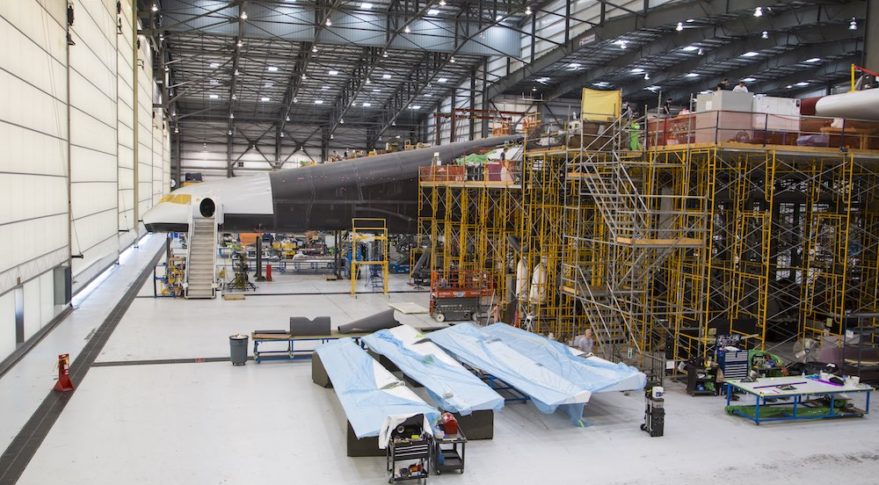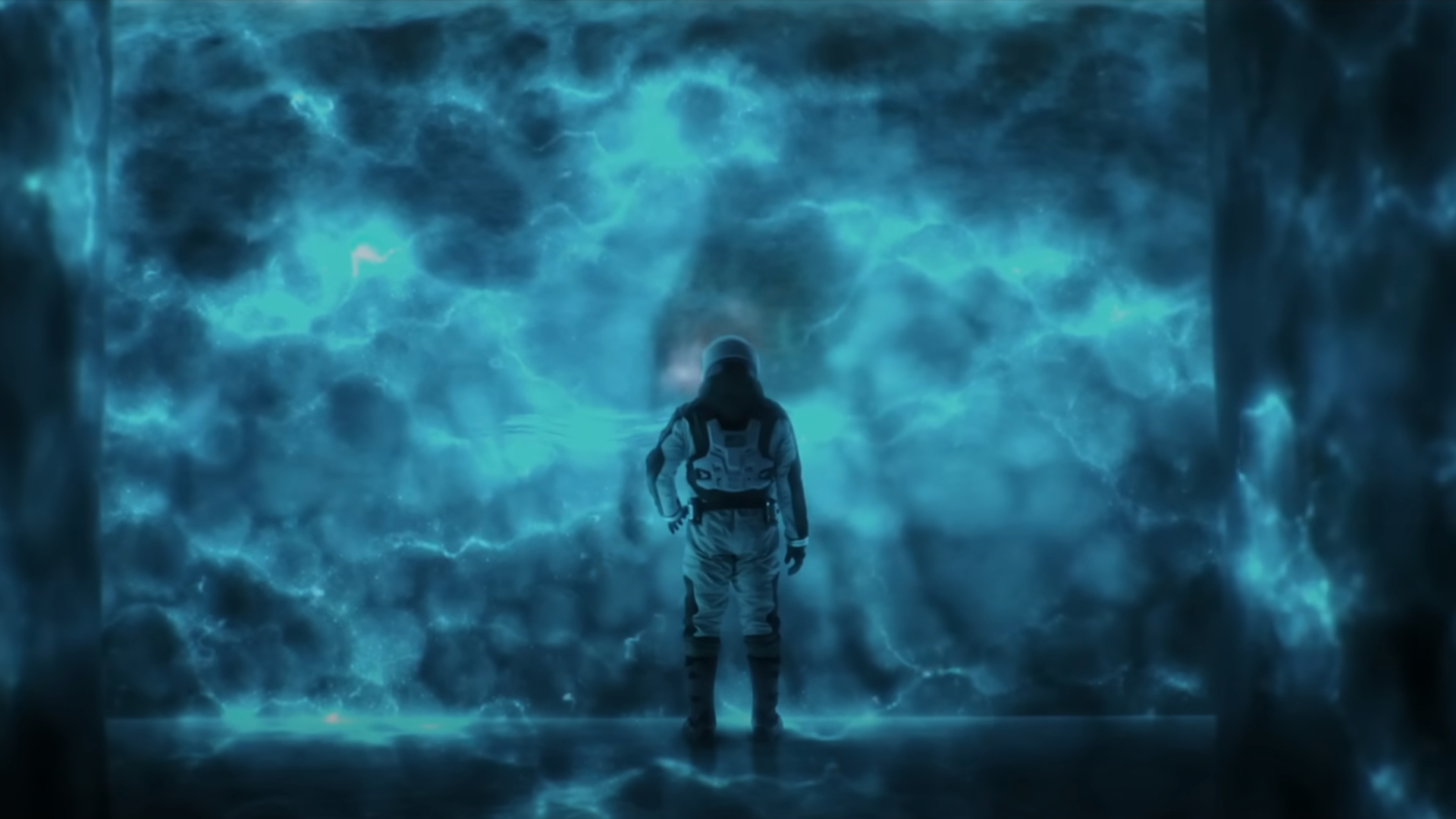Stratolaunch Seeks Launch Partners as Aircraft Nears Completion

MOJAVE, Calif. — As work on its giant aircraft nears completion, Stratolaunch Systems is still working to line up partners to provide launch vehicles to serve the growing small satellite market.
In a rare media tour of the company's aircraft assembly facilities here June 16, executives said Stratolaunch is still working with a number of unnamed companies on launch vehicles that would be flown from the plane, with plans to eventually work with multiple providers.
"We are developing and fostering lots of different partnerships," said Chuck Beames, president of Vulcan Aerospace and executive director of Stratolaunch Systems. "I would say that no company is ruled out right now."
He emphasized any arrangements with launch vehicle providers would not treat those companies as suppliers, but instead as partners in the overall venture. "We have lots of different partnership opportunities I can't talk about yet," he said, declining to name any of companies Stratolaunch is in talks with. "I don't know who will be first."
When Paul Allen, the Microsoft co-founder whose Vulcan Inc. is developing Stratolauncher, unveiled the concept in December 2011, the focus was on medium-class payloads, served at the time by the Delta 2, as well as potential launches of crewed spacecraft. Initially, Stratolaunch planned to use a variant of SpaceX's Falcon 9 with four or five engines.
A year later, SpaceX and Stratolaunch parted ways, and in 2013 Stratolaunch contracted with Orbital Sciences Corp. (now Orbital ATK) on a two-stage vehicle dubbed Thunderbolt using a solid lower stage and an upper stage powered by an Aerojet Rocketdyne RL10 engine. That effort, also focused on medium-class payloads, has since been put on hold.
Stratolaunch has since pivoted to serve the emerging small satellite market, while keeping open the option to support larger payloads. That smallsat interest, Beames said, includes both "venture-class" spacecraft intended to be proofs of concept of specific technologies intended for a future satellite constellation as well as deployment and replenishment of those constellations in low Earth orbit.
Breaking space news, the latest updates on rocket launches, skywatching events and more!
"We can serve a large class of satellite operators," he said, adding that Stratolaunch could serve those customers better than other launch providers by offering multiple launch vehicles. "Rather than go for a point solution, such as the biggest rocket we could possible carry, we're taking a very clear direction of servicing the entrepreneur and really helping to revolutionize the utility of LEO."
Aircraft Development
Stratolaunch Systems also used the tour to show off the progress it is making with its aircraft. The six-engine, twin-fuselage airplane currently known as Roc (but which may be renamed, Beames said) will be the largest in the world by wingspan when complete, at 117.3 meters.

The plane is a mix of state-of-the-art technologies in carbon composite materials as well as heritage components. Stratolaunch purchased two used Boeing 747 aircraft and took from them their jet engines, landing gear and cockpits. One of the cockpits is being installed in the plane itself while the other is being used as a simulator for the three-person crews who will fly it.
"We tried to reuse as much of the Boeing 747 as we could," Beames said, "but this is actually a very special aircraft by nature of its size."
The plane will also be among the heaviest in the world, with a gross takeoff weight of about 590,000 kilograms, including up to 250,000 kilograms of payload in the form of the launch vehicle it will carry. The rest is evenly split among the aircraft's carbon composite components, its 747-heritage components, and fuel.
Company officials said the aircraft is about three-quarters complete. The tail assembly, or empennage, was in place on the rear of one fuselage during the tour, while components for the other were being assembled the factory floor.
Stratolaunch declined to give a schedule for completion of the aircraft, but Beames said he was satisfied with the progress the company was making on the plane. "I feel very good about where we are," he said.
In an interview last July, Beames said the aircraft would be rolled out by early 2016, with flight tests beginning by mid-year. He said at the tour there was no specific issue that was delaying its development, beyond the issues of building a one-of-a-kind plane like this.
"It turned out to be more challenging than they anticipated," he said of the aircraft's designers at Scaled Composites. He credited them with innovations in its development, but the scale of the work, he said, created unique challenges. "The common denominator is just building an aircraft of this magnitude. It required thinking and innovation that Scaled certainly delivered on."
Schedule and Competition
Beames was also hesitant to give a date when Stratolaunch would enter commercial service. "In terms of the overall plan, we're on track," he said. "I feel very confident that we have healthy margins built into Paul's original goal of by the end of the decade."
In fact, when Paul Allen announced Stratolaunch in late 2011, he and other company officials discussed having the plane completed by 2015 with test launches starting in 2016. Beames noted that he joined the company about two and a half years ago, long after that original announcement.
He said getting the aircraft and overall system done right was more important that meeting a specific schedule. "While this piece, the aircraft, we would love for it to be done today, it's important that we get it right," he said. "I think it's been worth the redoubling of attention to detail to make sure we're getting this done right."
Beames said Stratolaunch is discussing schedules with potential customers, although under non-disclosure agreements. "We're very interested in being their provider," he said of talks with potential customers.
Stratolaunch, though, is entering a crowded market as several other companies make progress on dedicated launch systems for smallsats, both conventional ground-launched rockets as well as other air-launch systems. Some of those companies are planning to make their initial launches as soon as later this year.
Beames said that Stratolaunch should stand out from the competition based on both its flexibility in accommodating multiple launch vehicles of different sizes, as well as its responsiveness. "I think we'll be the most responsive," he said. "There will be no more waiting years to test out a prototype system. There will be no more of the kinds of things that have frankly killed great ideas before they were literally able to get off the ground."
He added, though, that he thinks the market for smallsats will be large enough to support more than one launch provider. "There's a lot of folks in the launch business right now," he said. "A logical fallacy that a lot of people fall into is that they think that there's only going to be one winner in the end. I don't think that's the case."
Originally published on Space News.
Join our Space Forums to keep talking space on the latest missions, night sky and more! And if you have a news tip, correction or comment, let us know at: community@space.com.

Jeff Foust is a Senior Staff Writer at SpaceNews, a space industry news magazine and website, where he writes about space policy, commercial spaceflight and other aerospace industry topics. Jeff has a Ph.D. in planetary sciences from the Massachusetts Institute of Technology and earned a bachelor's degree in geophysics and planetary science from the California Institute of Technology. You can see Jeff's latest projects by following him on Twitter.
